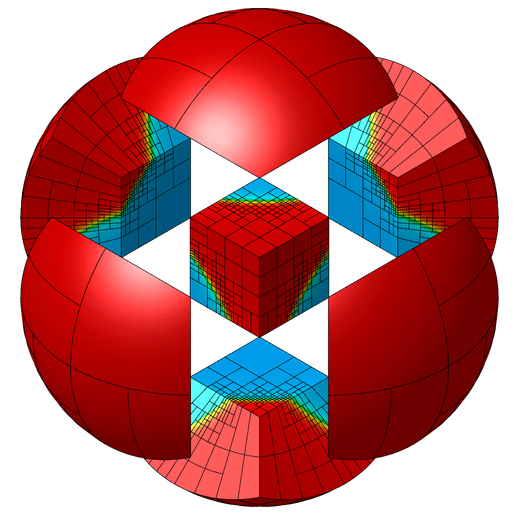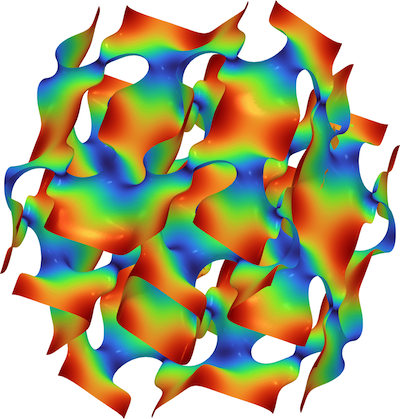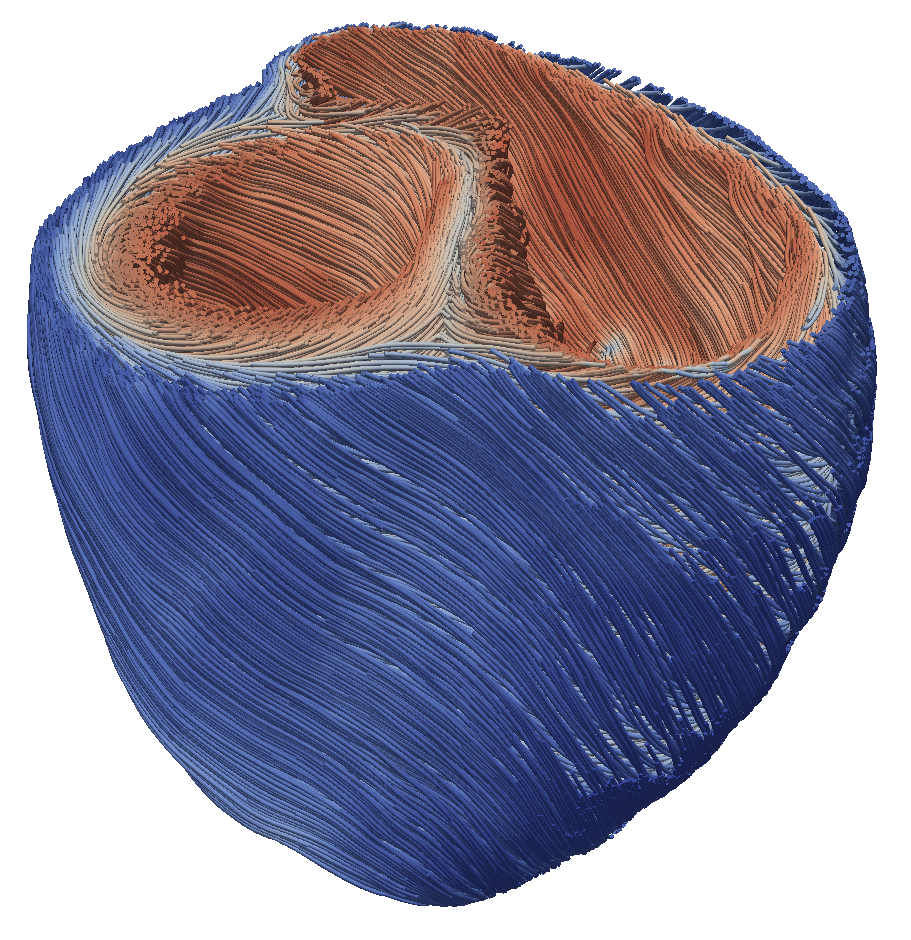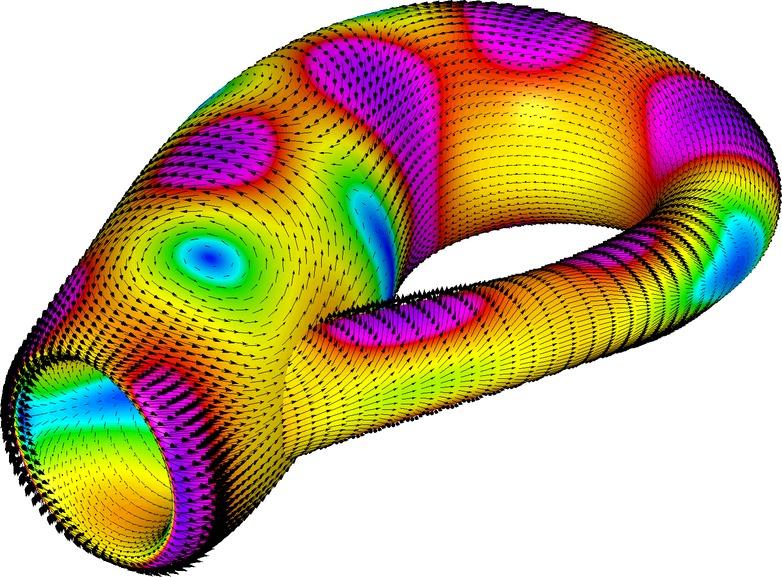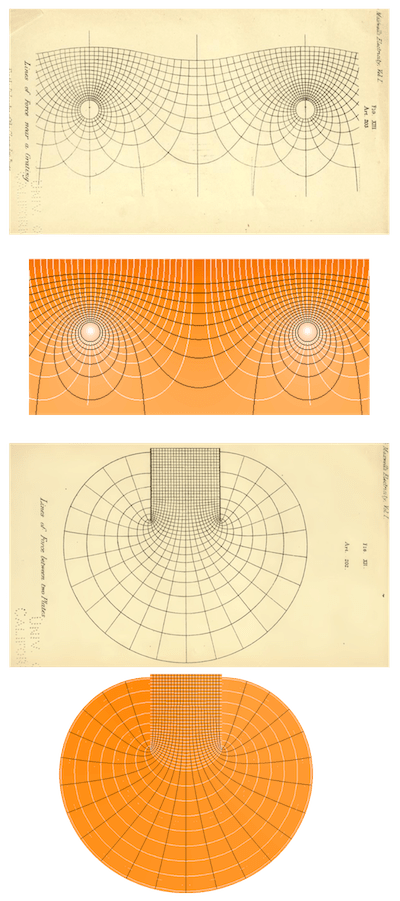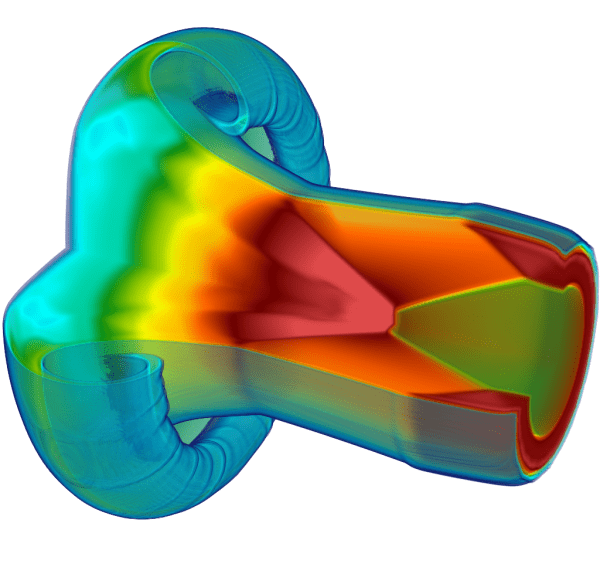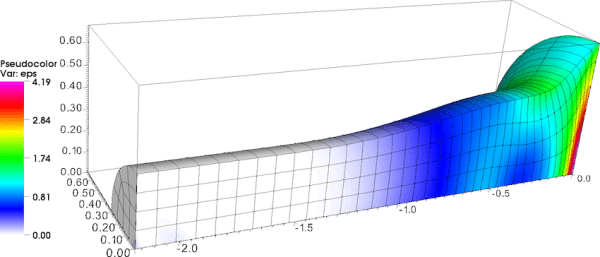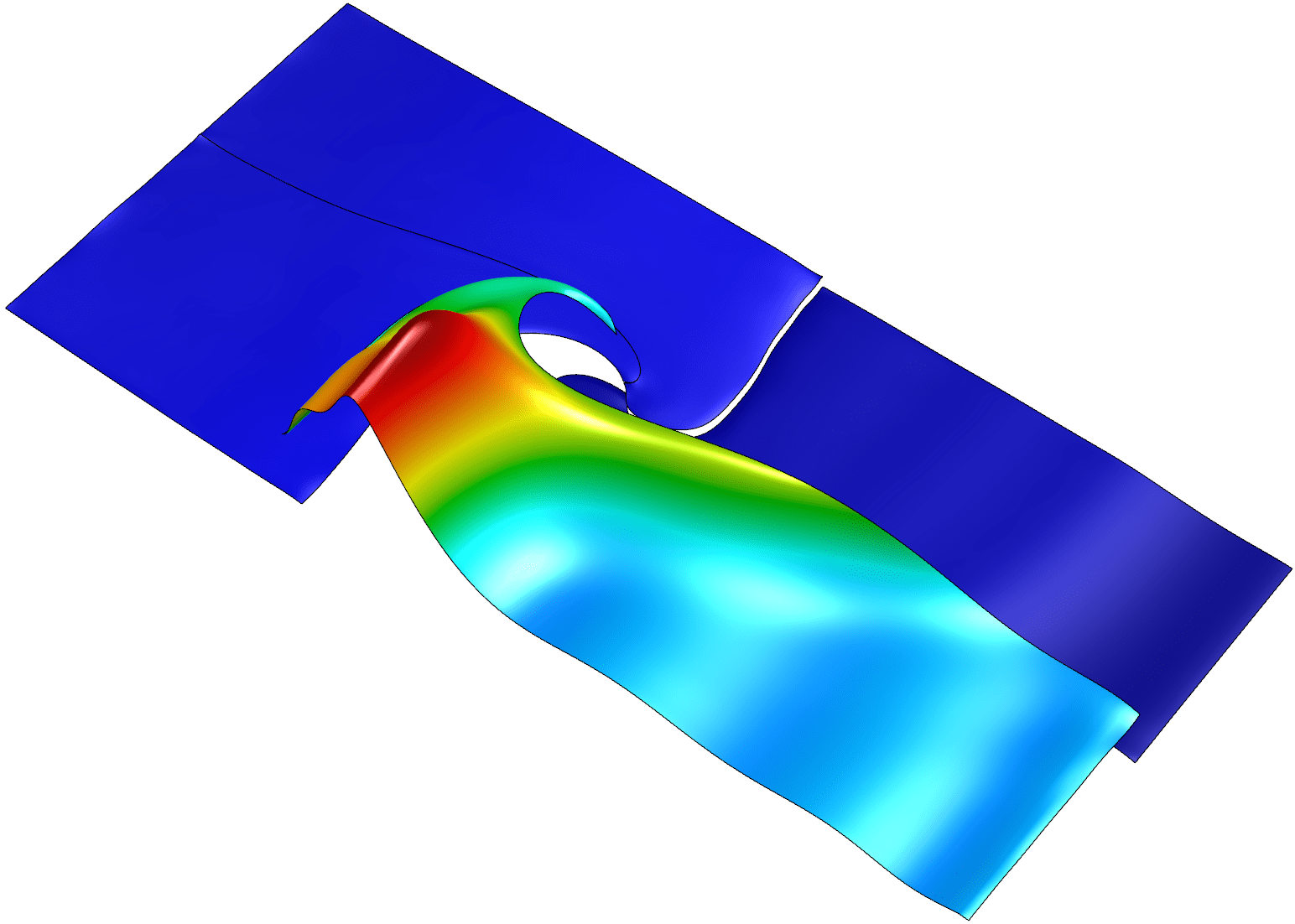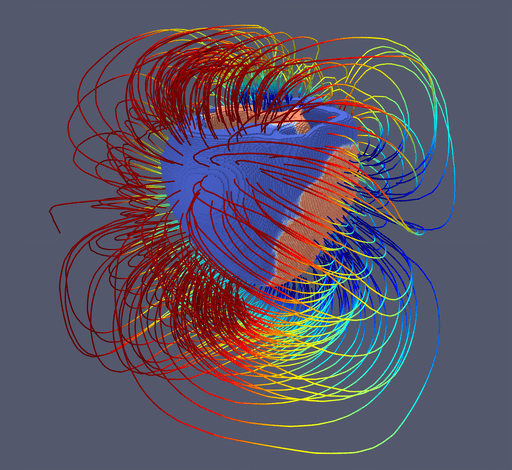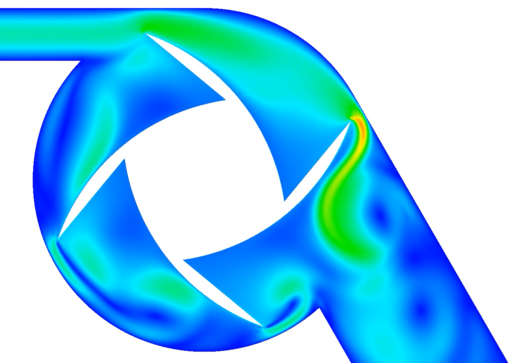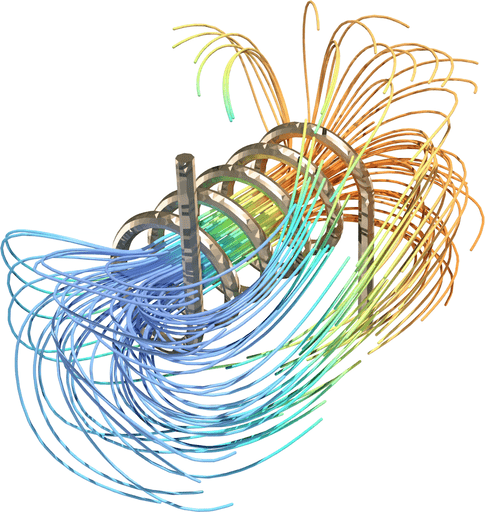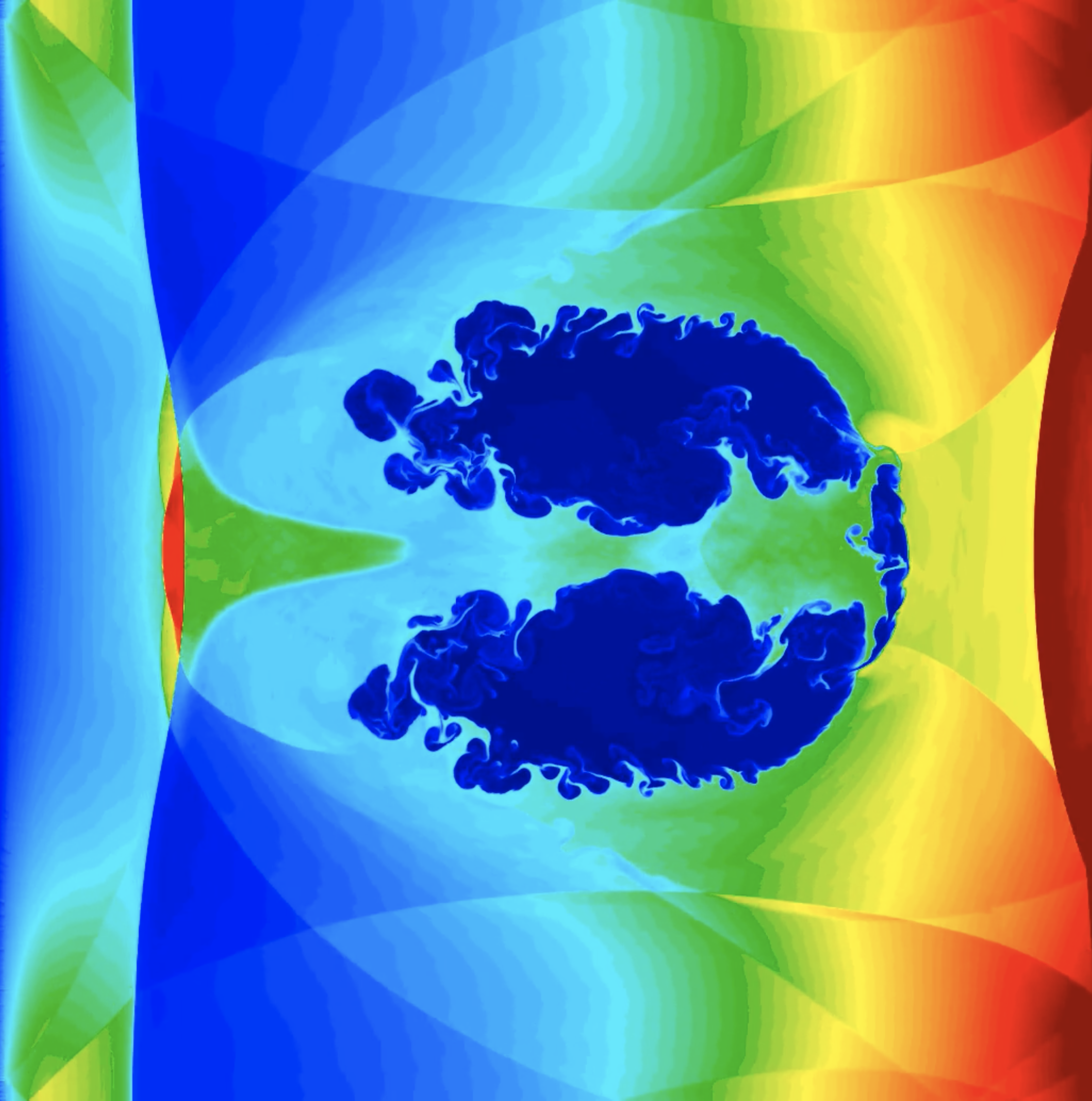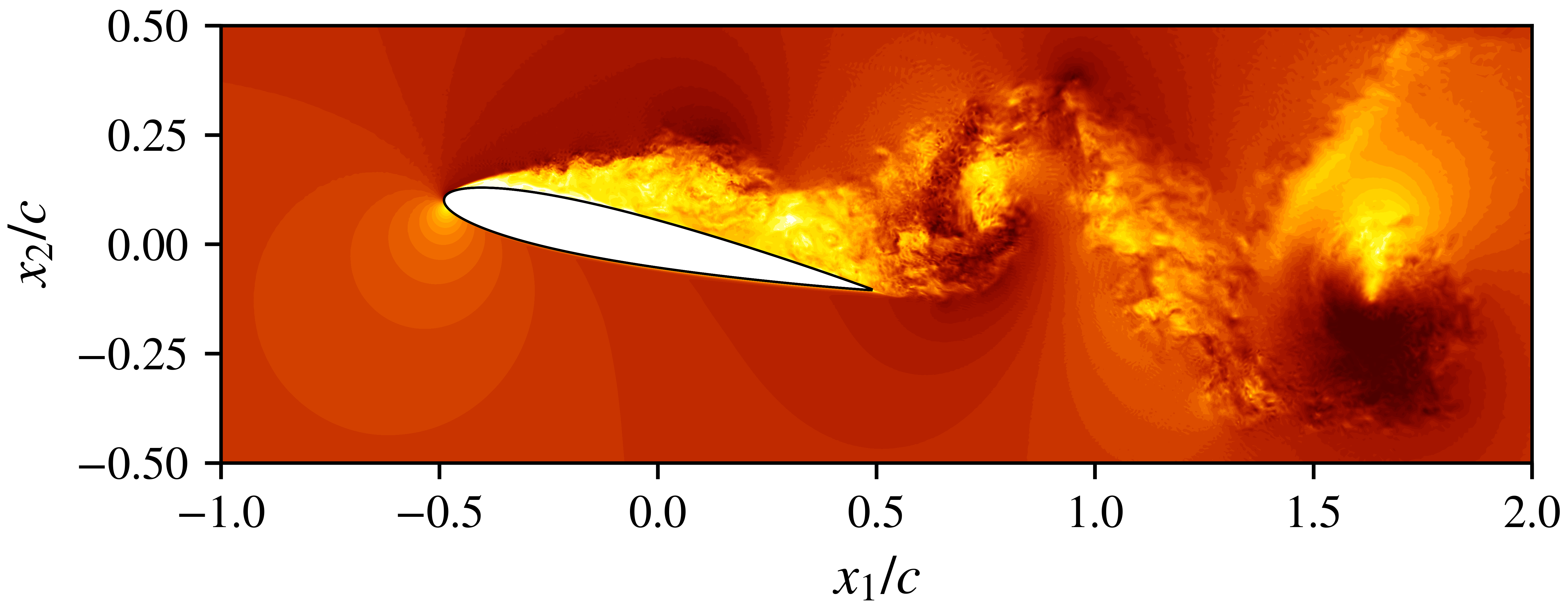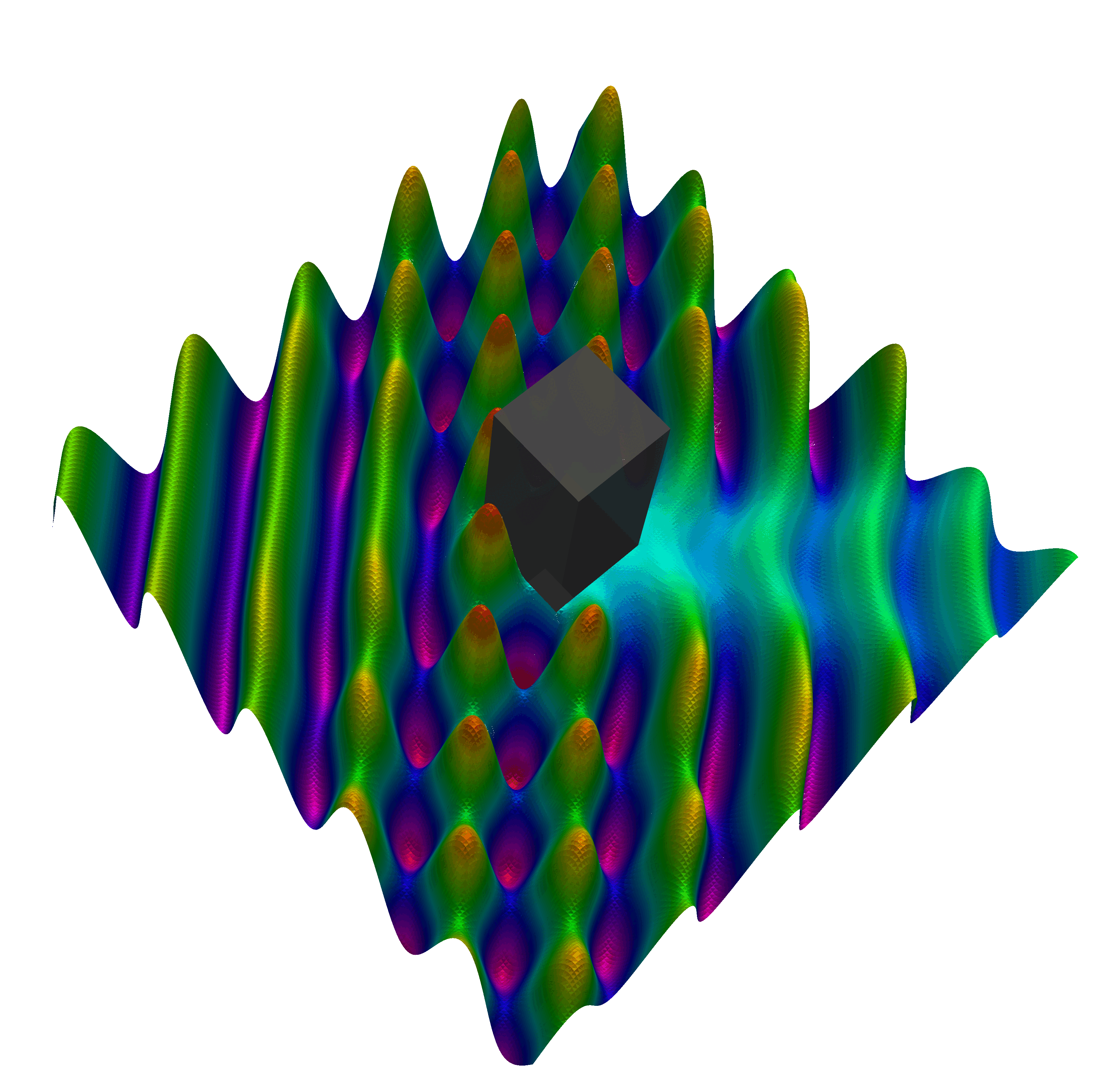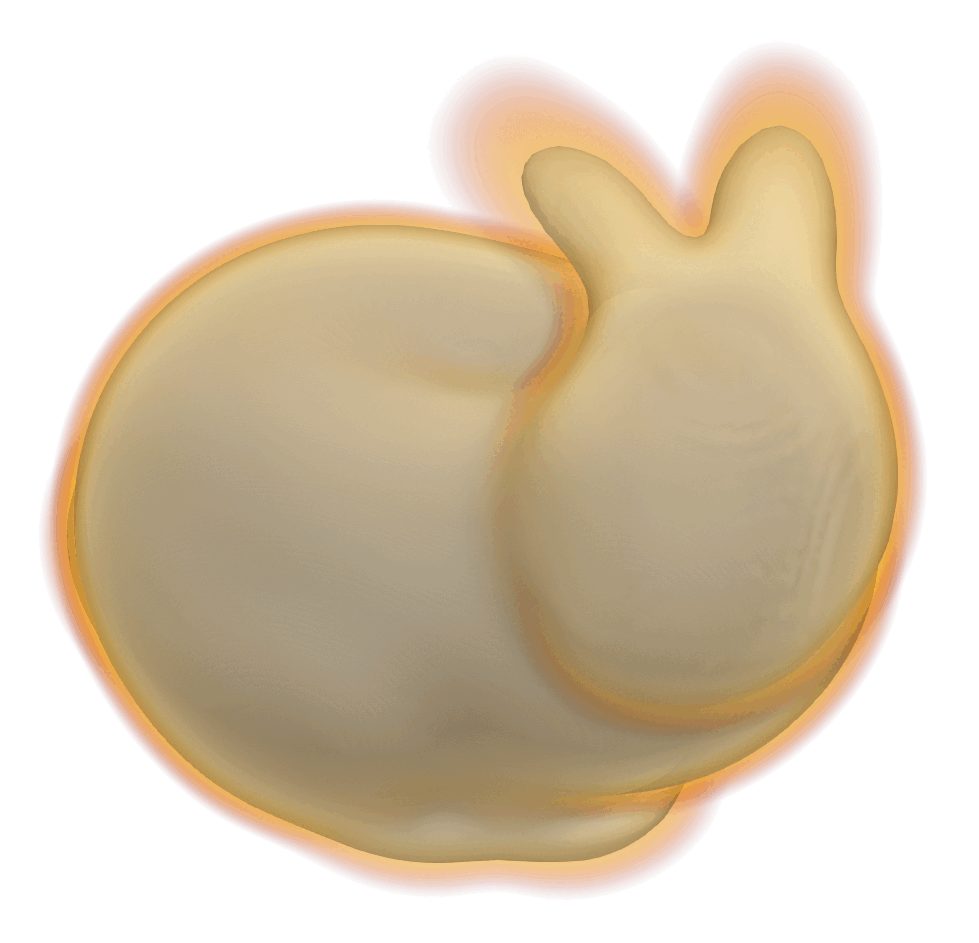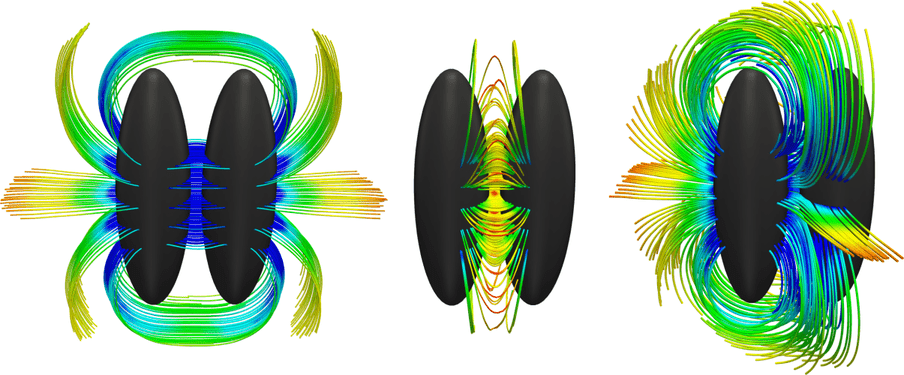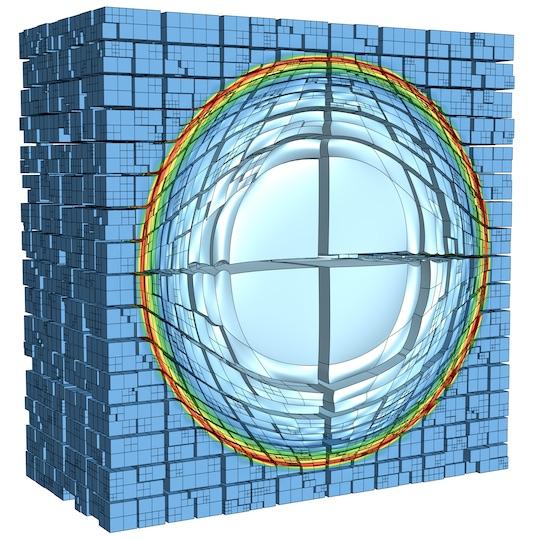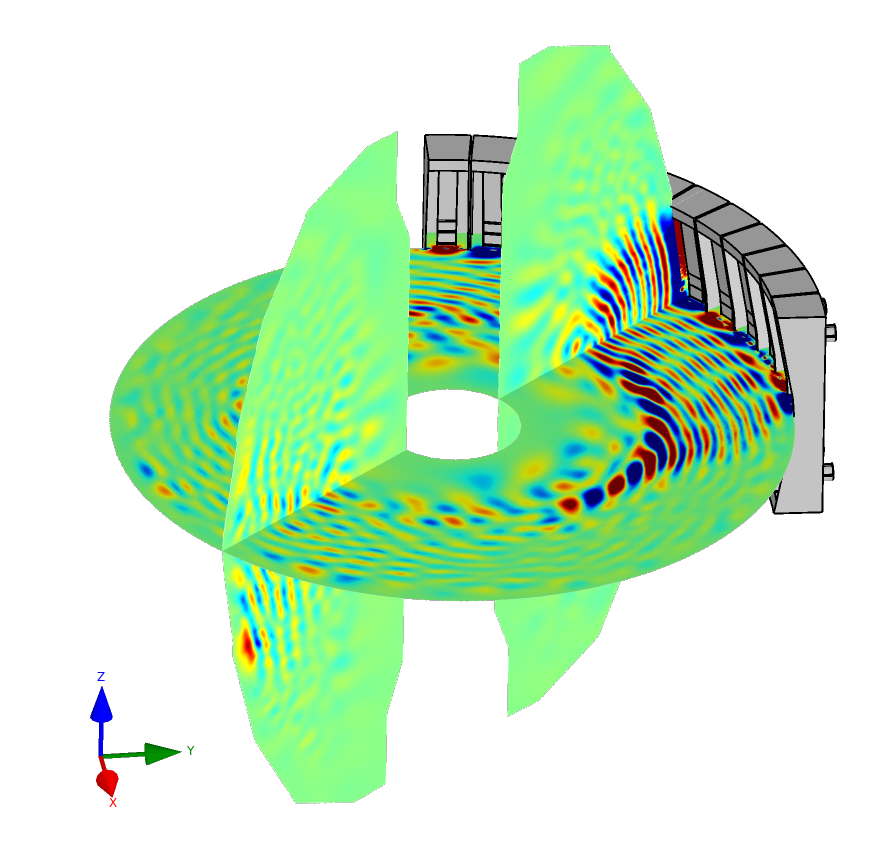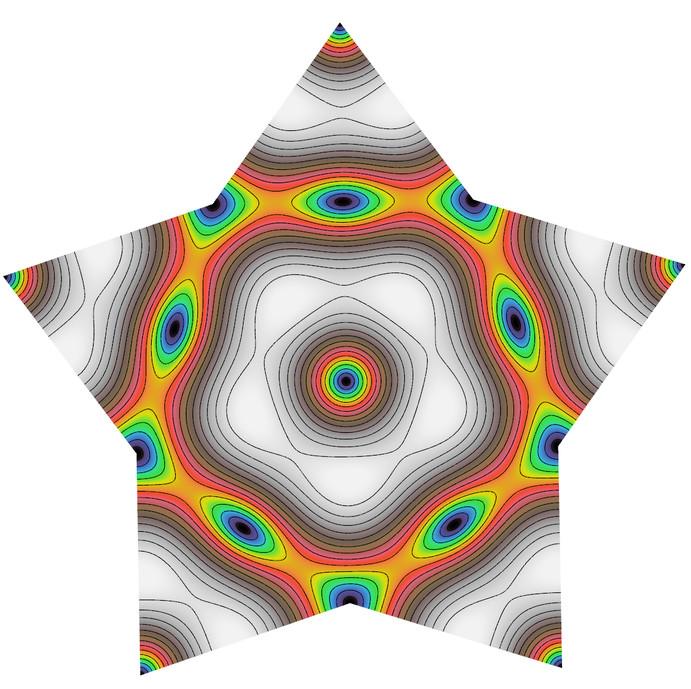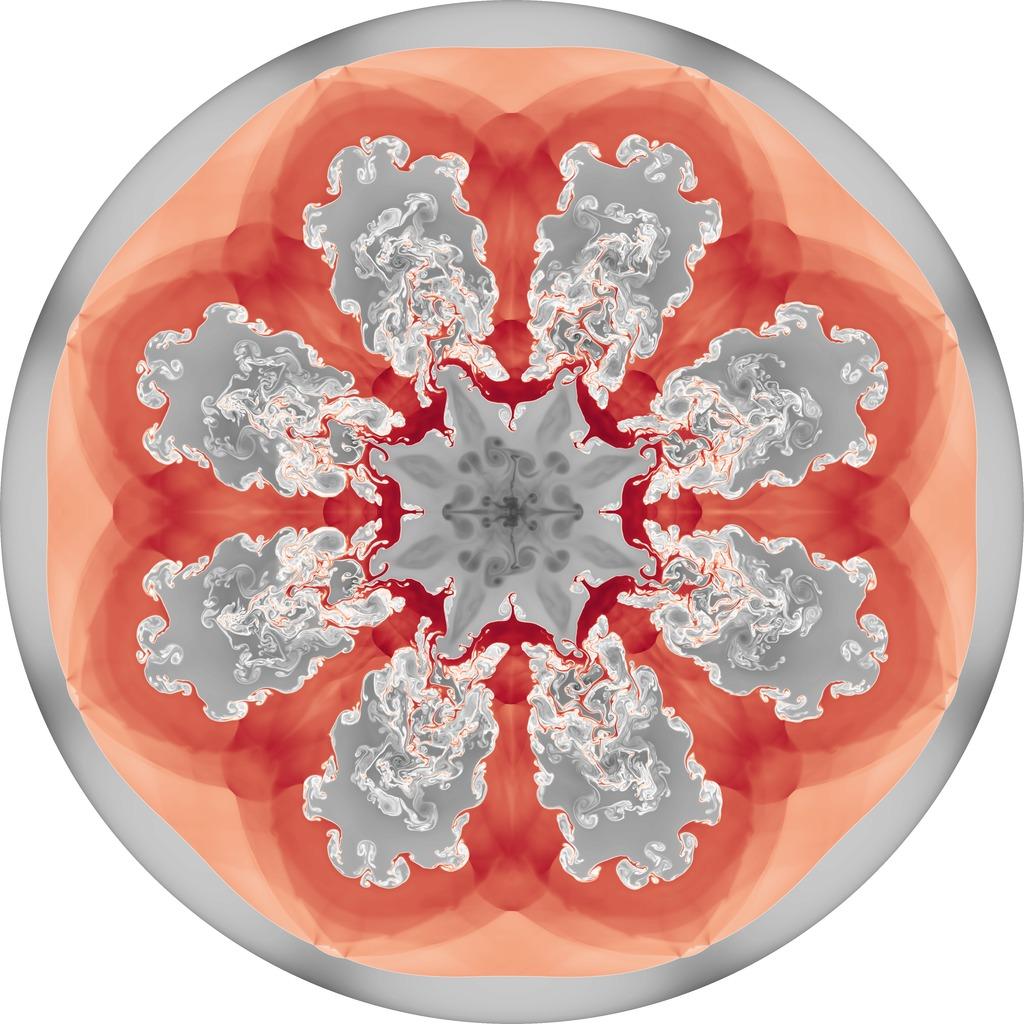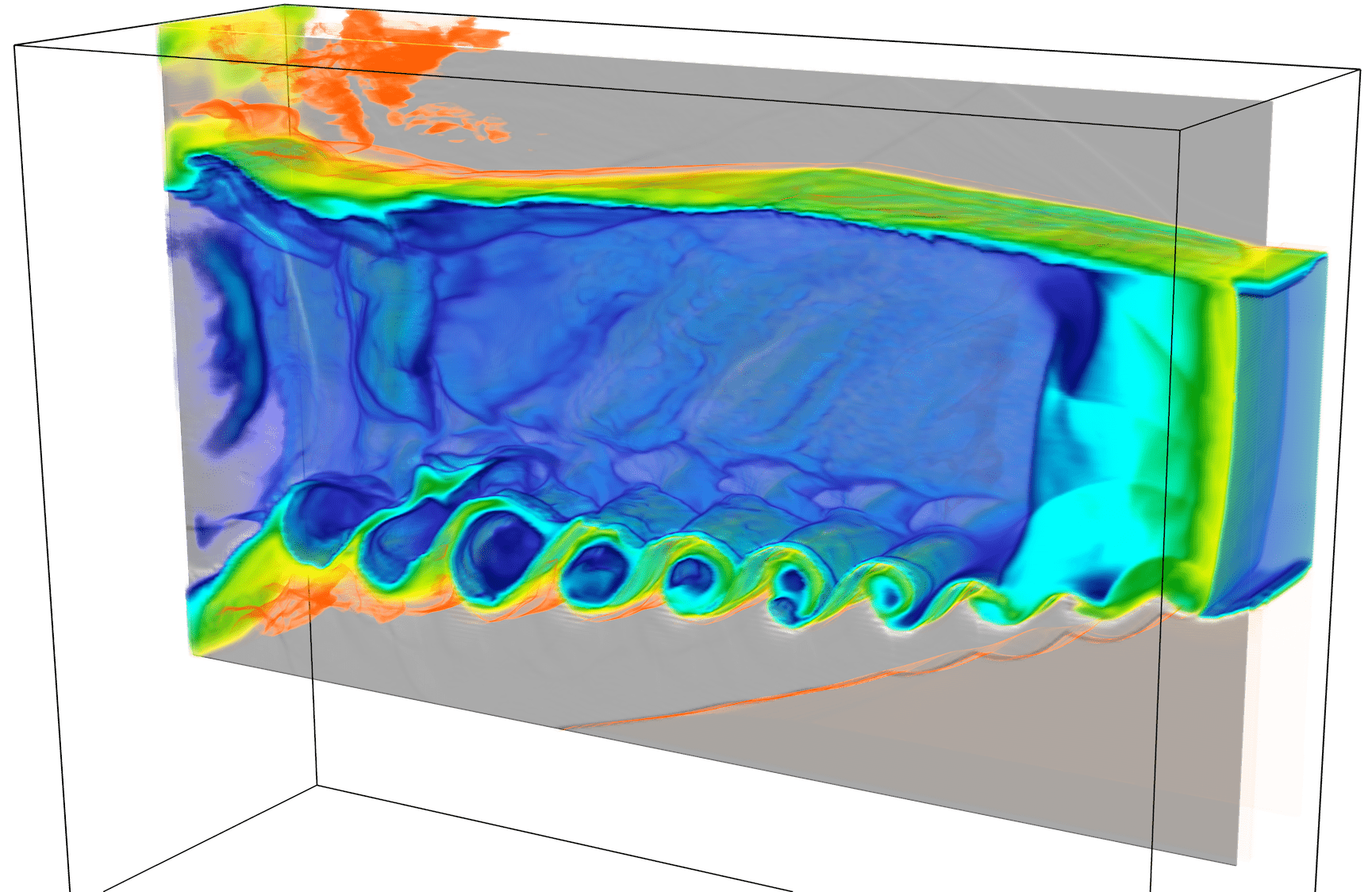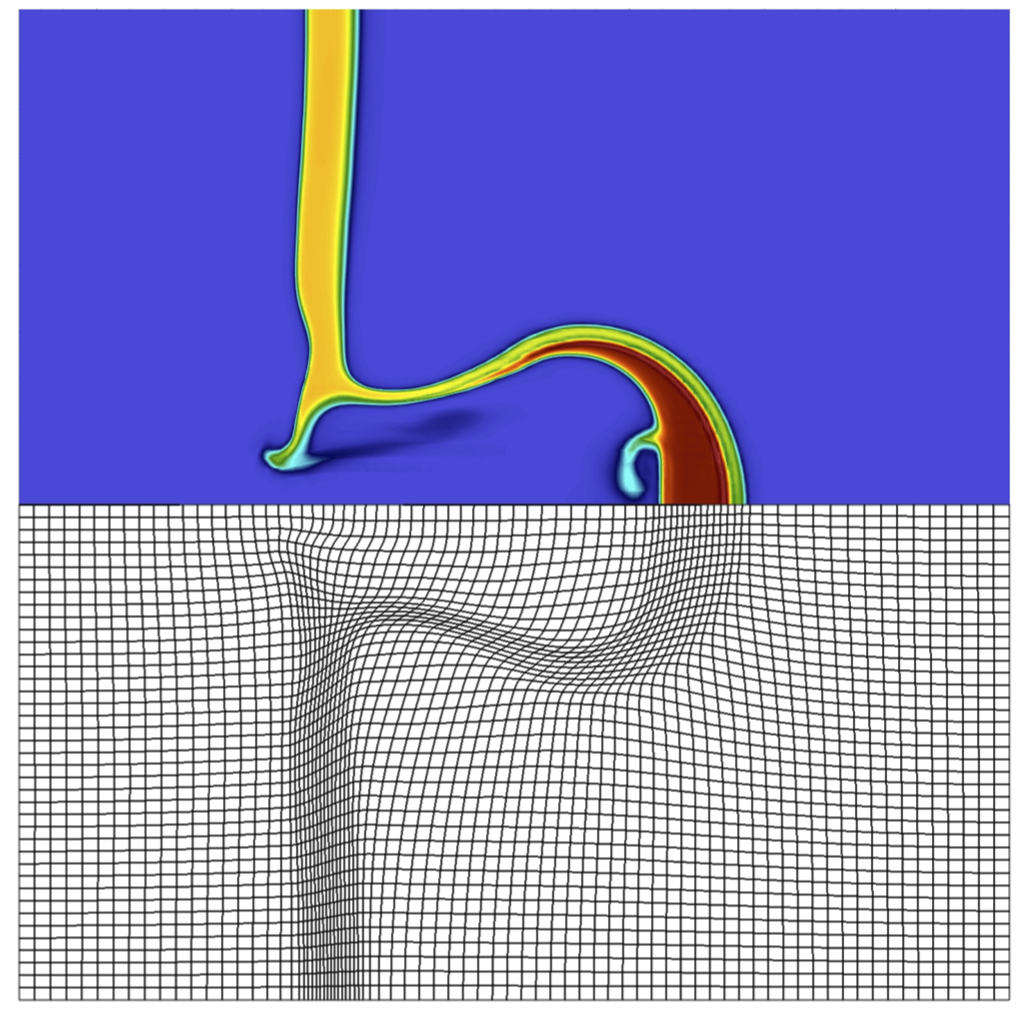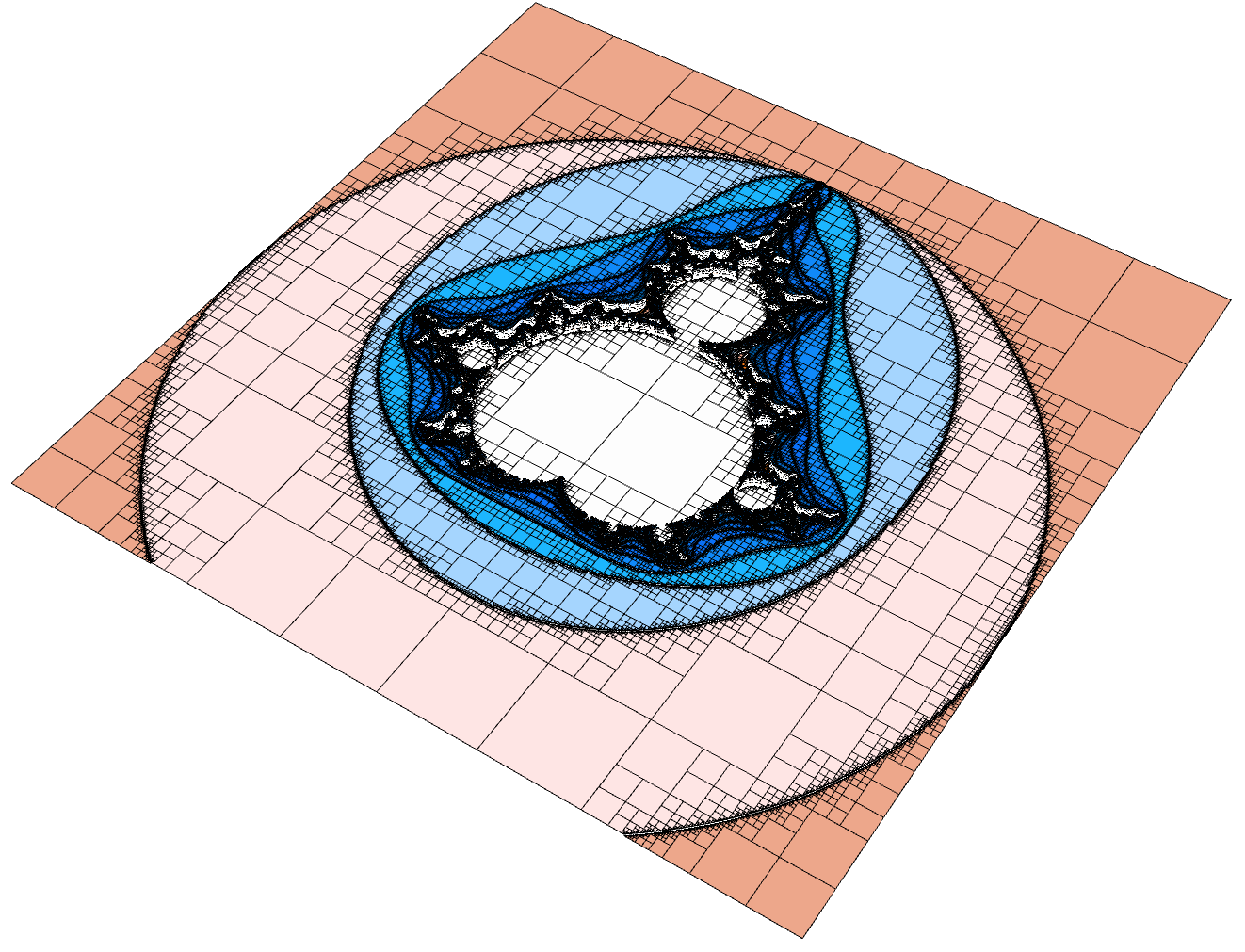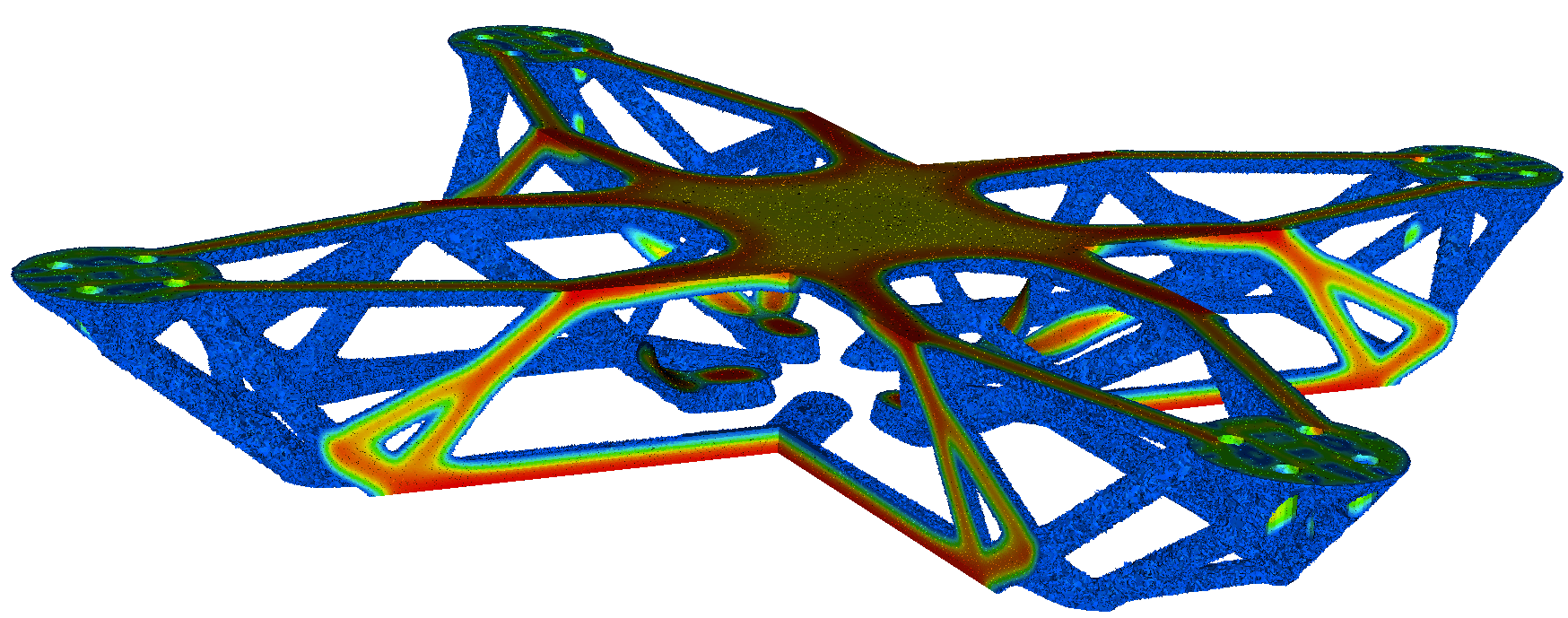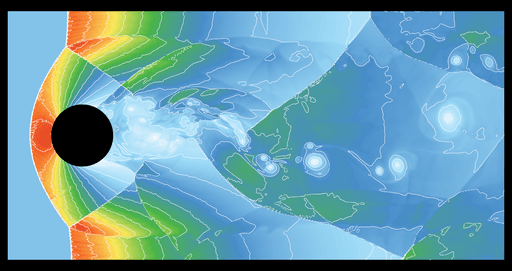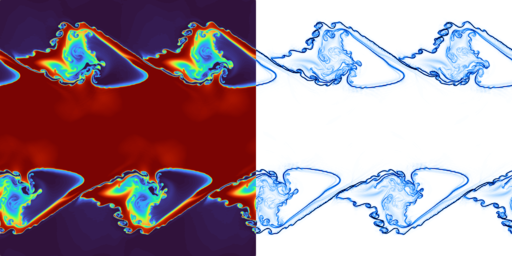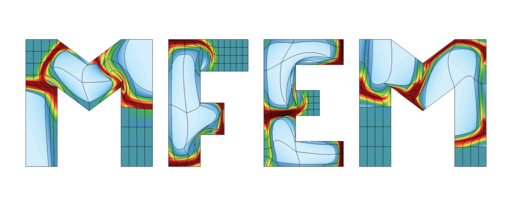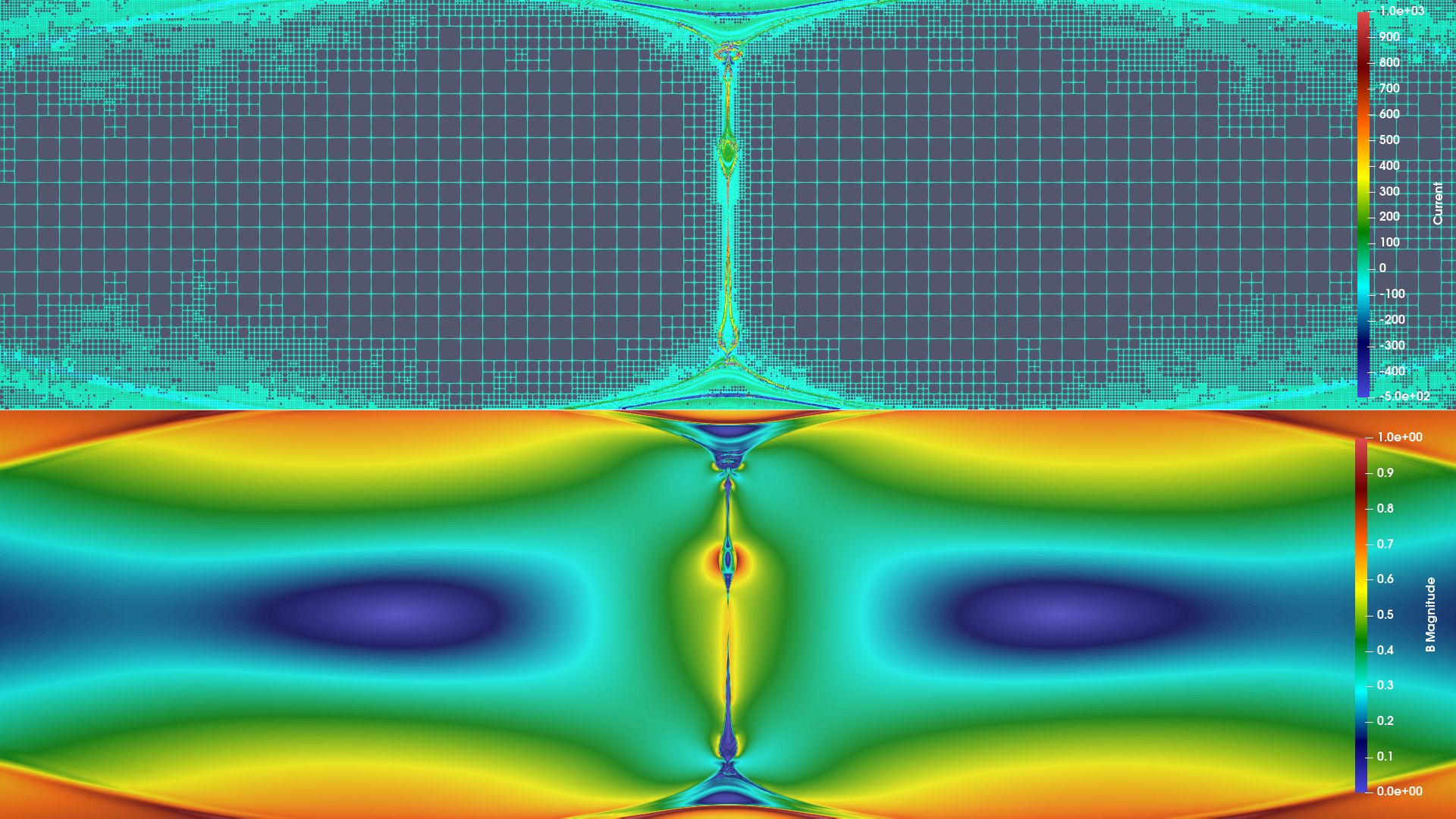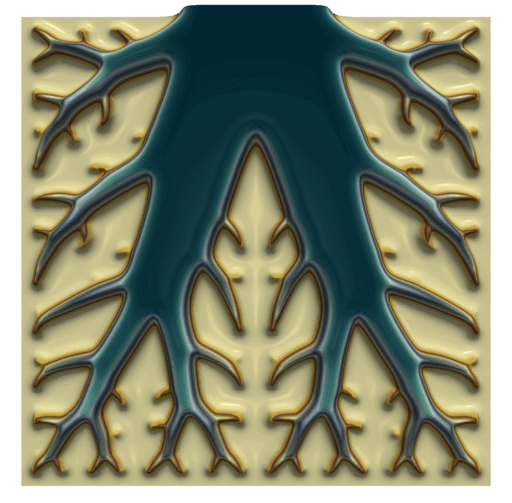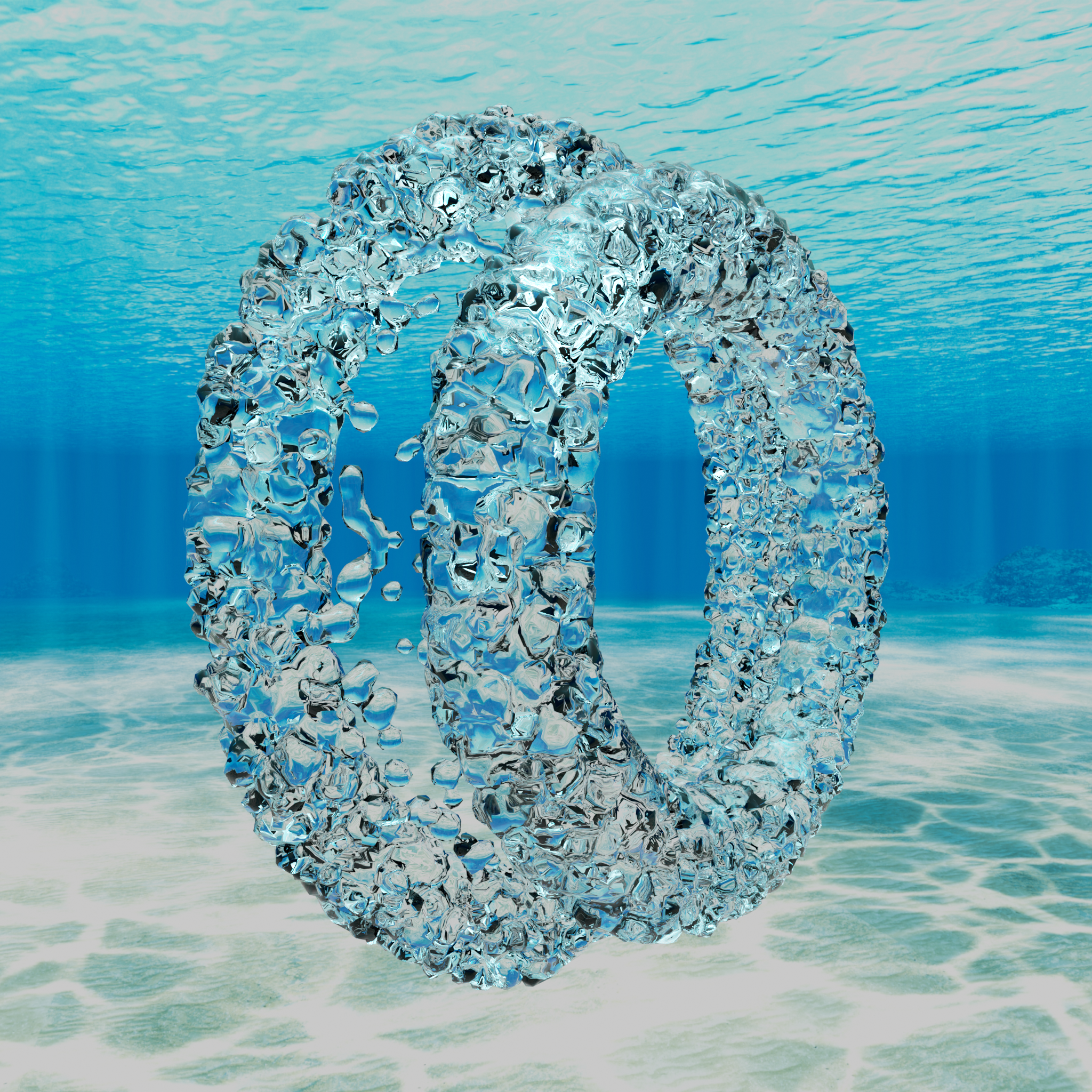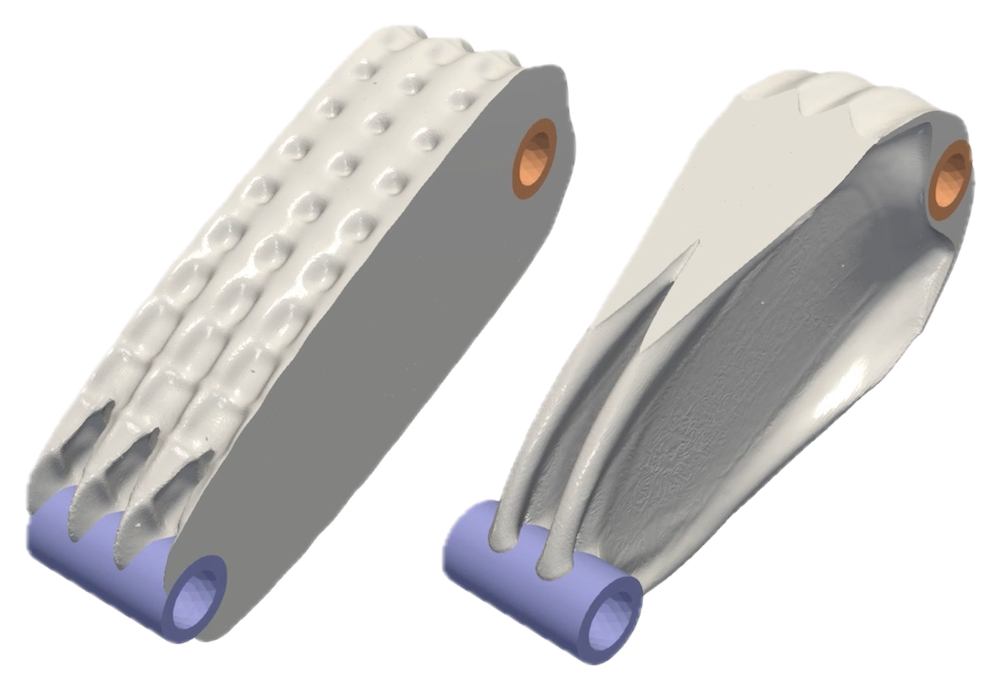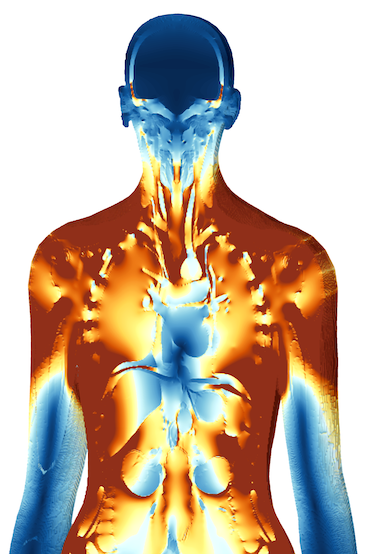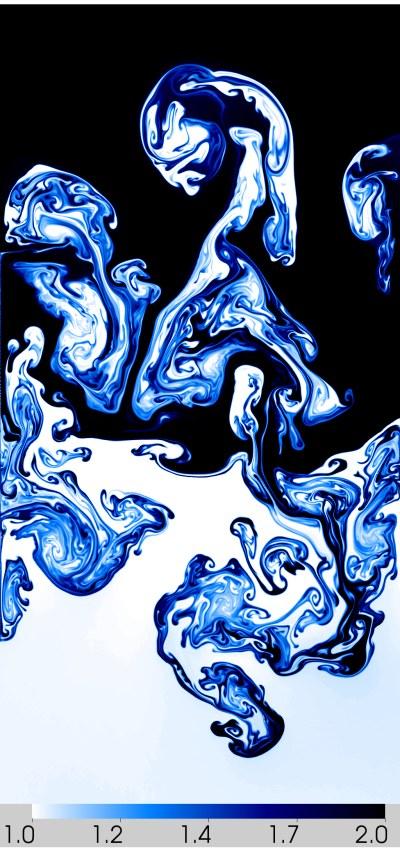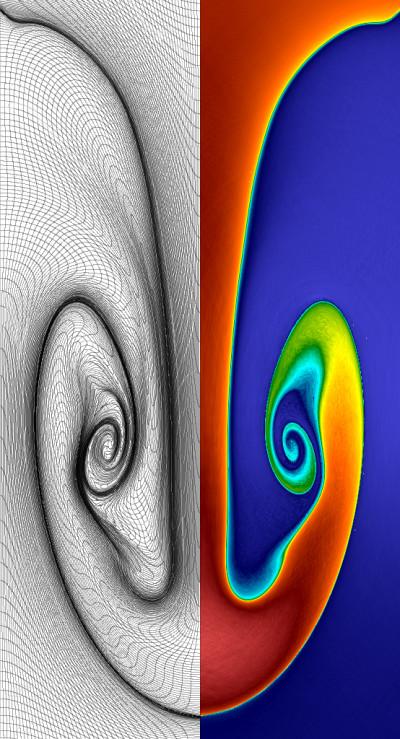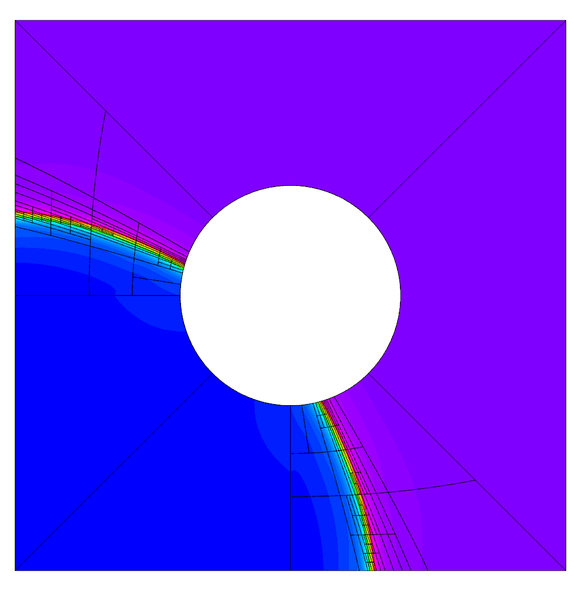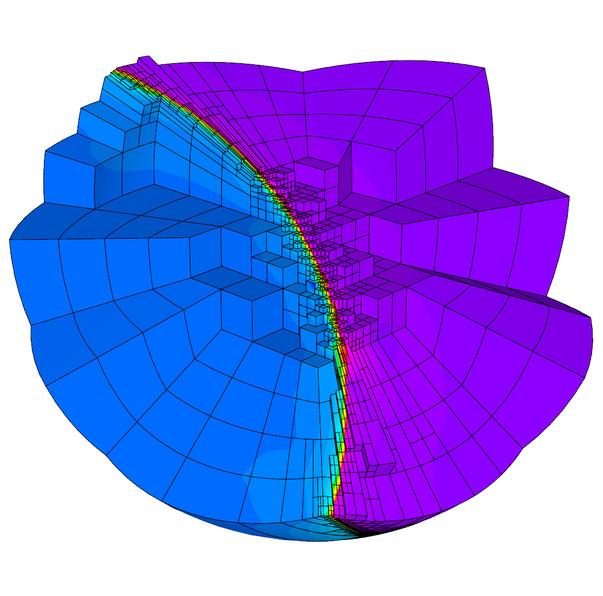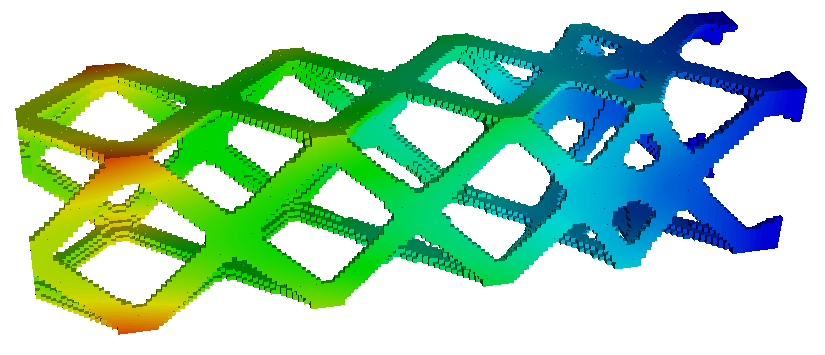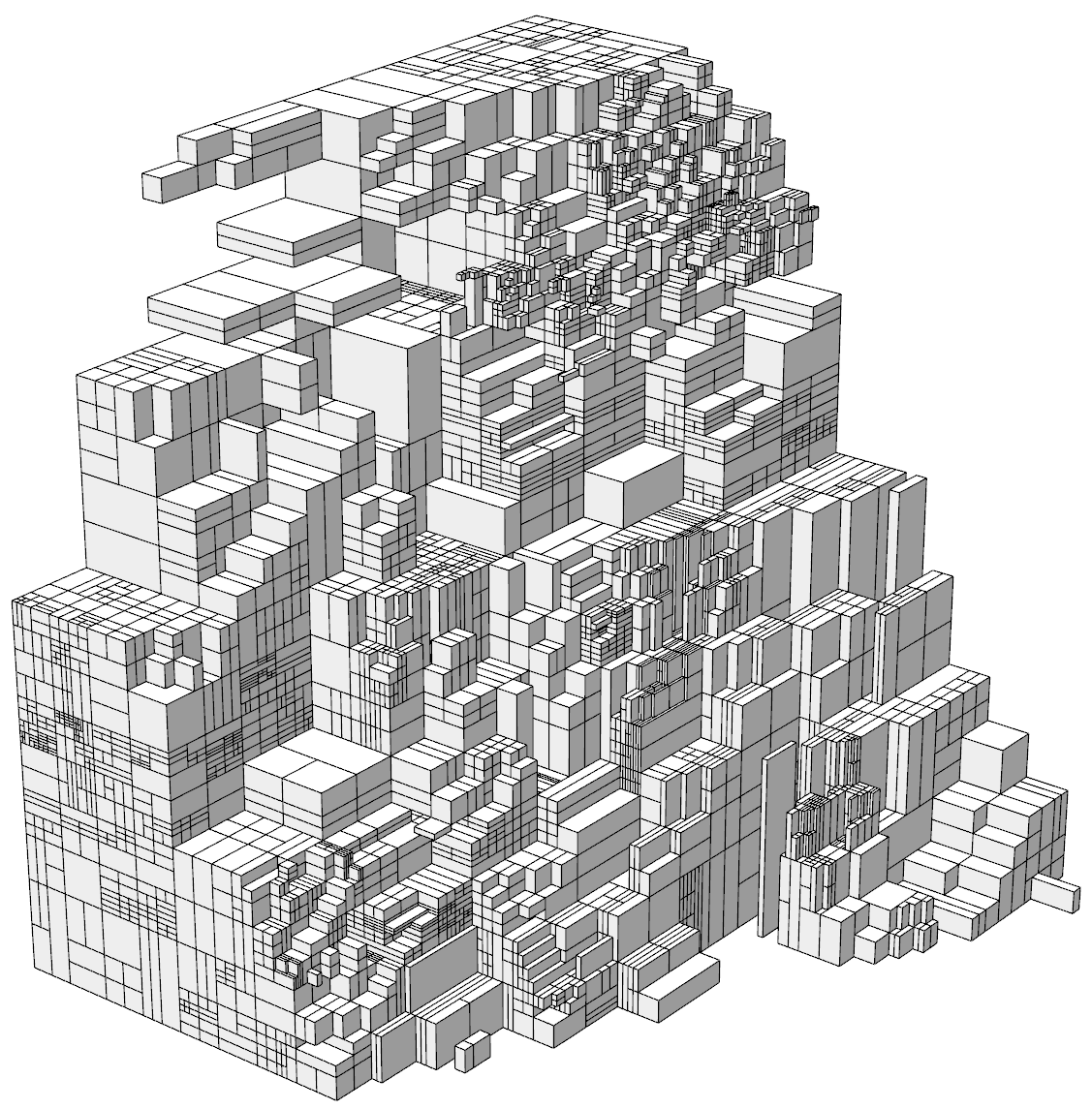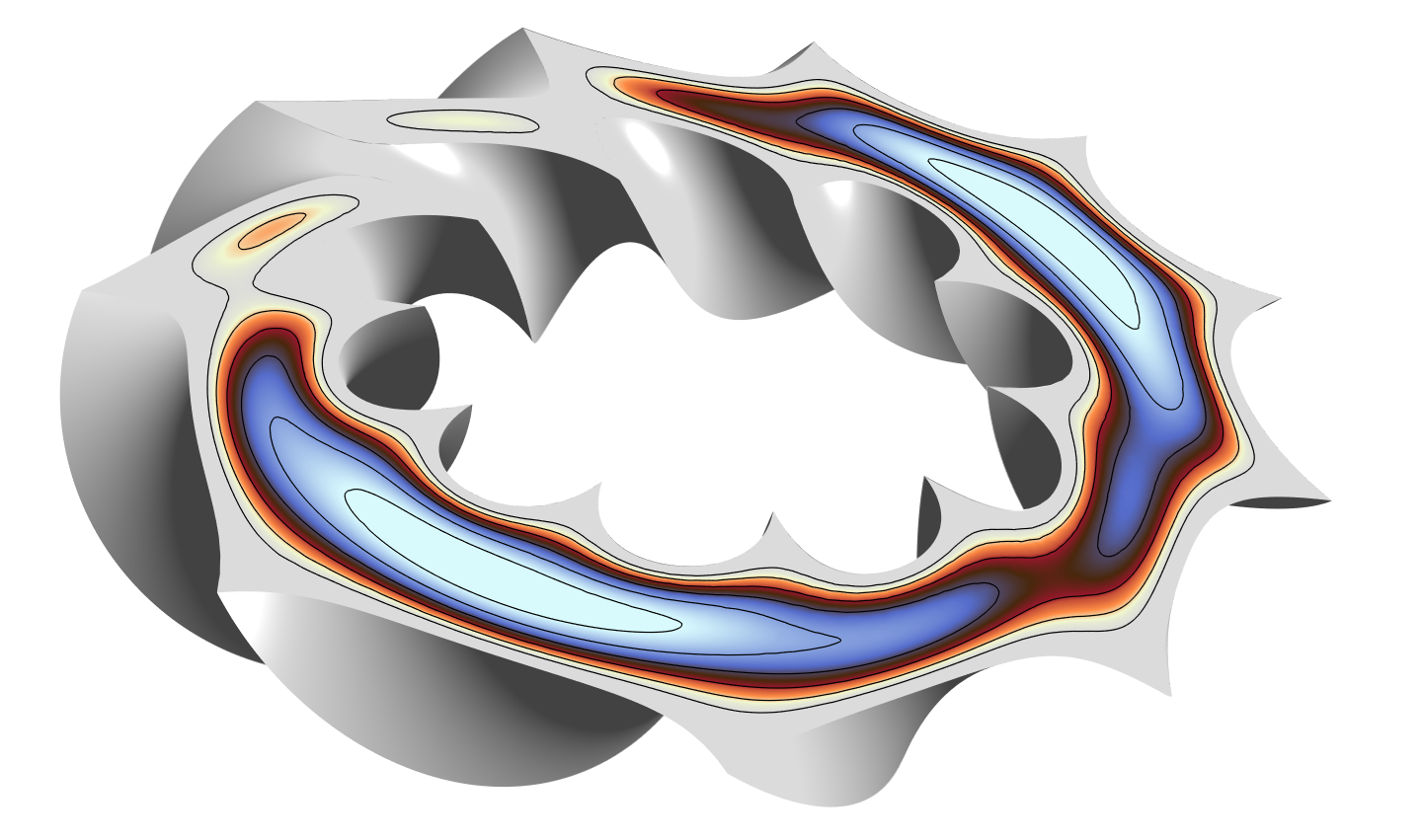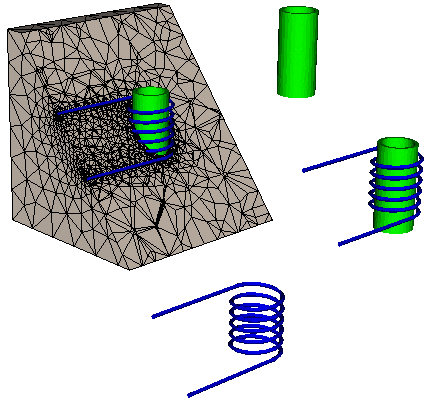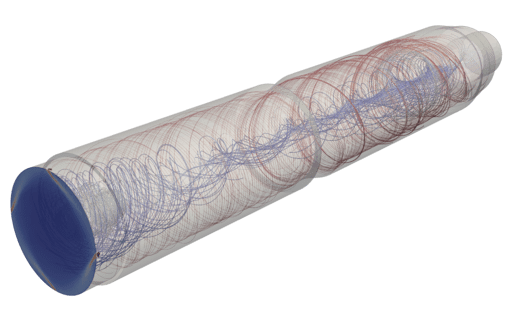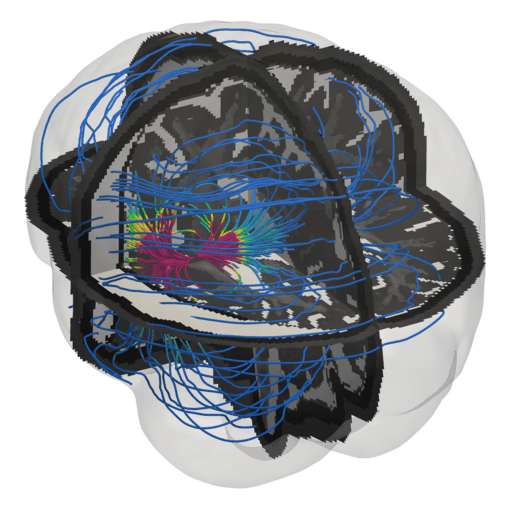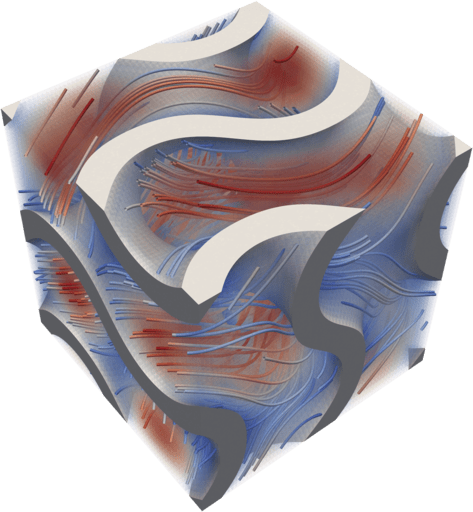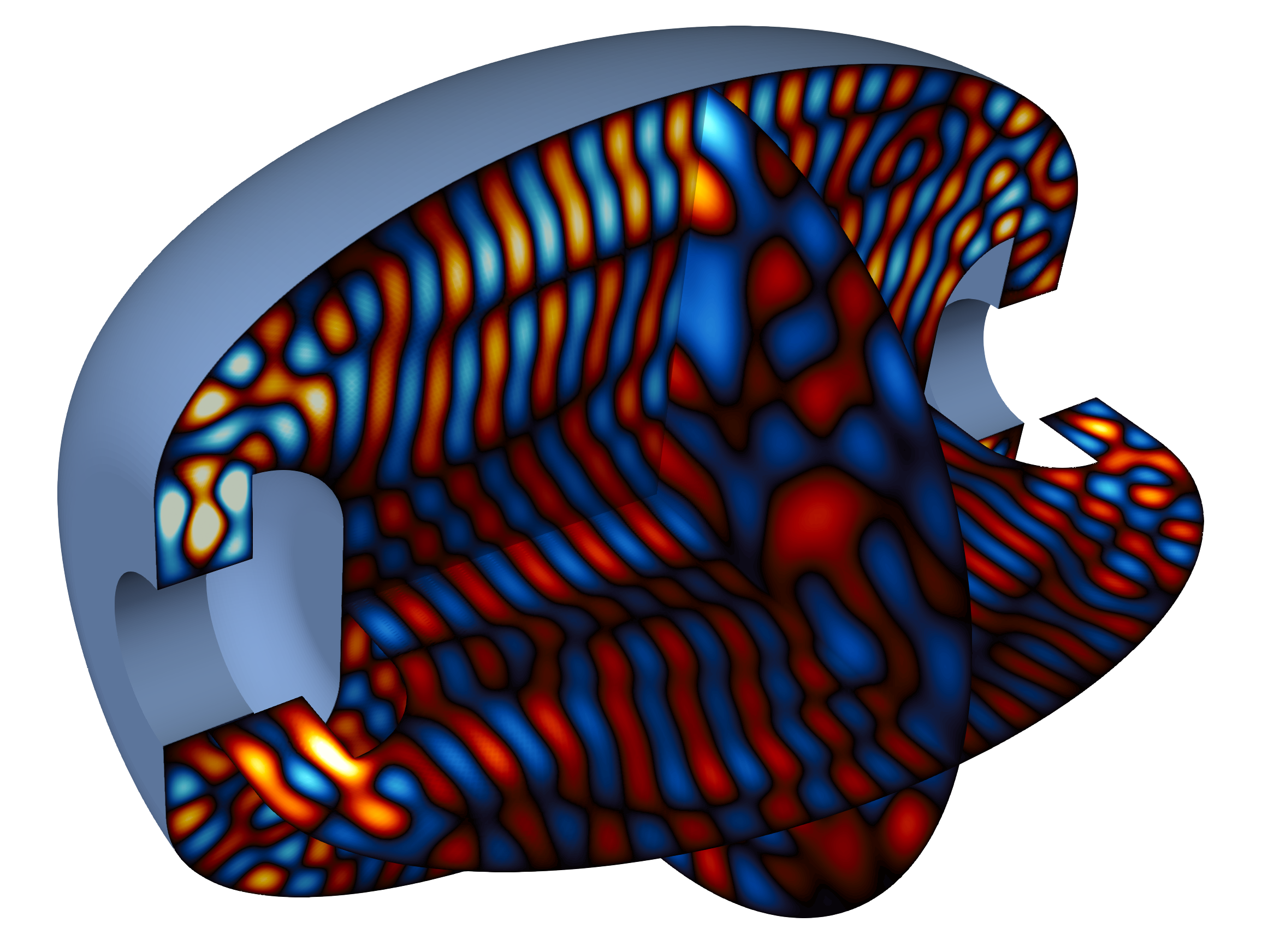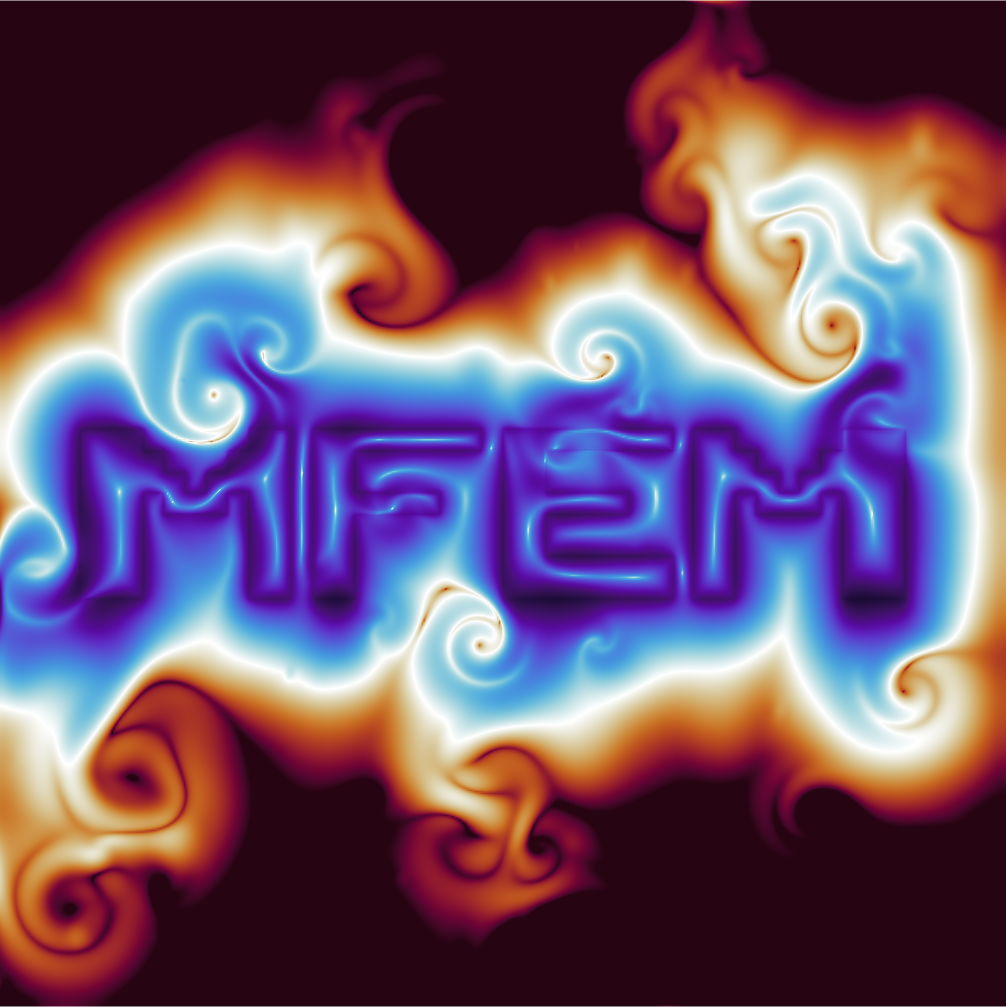Gallery
This page collects screenshots from various simulations based on MFEM.
Image captions with 🎬 link to simulation videos. Additional images can be found in the GLVis gallery.
A version of the MFEM logo demonstrating curvilinear elements, adaptive mesh refinement and (idealized) parallel partitioning. Visualization with GLVis.
Incompressible Taylor-Green vortex simulation with high-order finite elements. Visualization with ParaView.
Fibers generated by LDRB approach based on 4 Laplacian solves in the Cardioid project.
Solution of a Maxwell problem on a Klein bottle. Mesh generated with the klein-bottle miniapp. Solution with Example 3.
Comparisons of equipotential surfaces and force lines from Maxwell's Treatise on Electricity and Magnetism with results from MFEM's Volta miniapp.
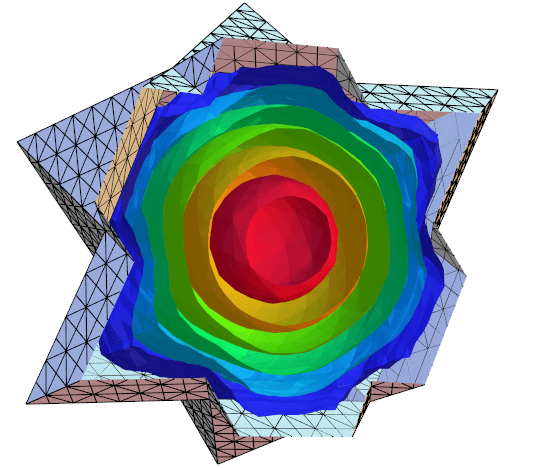
Level surfaces in the interior of the solution from Example 1 on escher.mesh. Visualization with GLVis.
3D Arbitrary Lagrangian-Eulerian (ALE) simulation of a shock-triple point interaction with Q2-Q1 elements in the MFEM-based BLAST shock hydrodynamics code. Volume visualization with VisIt.
Modeling elastic-plastic flow in the 3D Taylor high-velocity impact problem using 4th order mixed elements in the MFEM-based BLAST shock hydrodynamics code. Visualization with VisIt.
Poisson problem on a "Breather" surface. Mesh generated with the Mesh Explorer miniapp. Solution with Example 1.
Triple point shock interaction on 4 elements of order 12. Note the element curvature and the high variation of the field inside the lower right element.
Visualization of the electric field generated by the electrical wave on rabbit heart ventricles during depolarization of the heart. Image courtesy of Dennis Ogiermann, winner of the 2021 MFEM Workshop Visualization Contest.
🎬 Incompressible fluid flow around a rotating turbine using a space-time embedded-hybridized discontinuous Galerkin discretization. Image courtesy of Tamas Horvath, winner of the 2021 MFEM Workshop Visualization Contest.
🎬 Magnetic diffusion problem solved to compute the magnetic field induced by current running through copper wire in air. Image courtesy of Will Pazner, winner of the 2022 MFEM Workshop Visualization Contest.
🎬 Shock-bubble-interaction using a Property-preserving discontinuous Galerkin scheme, see book. Image courtesy of Hennes Hajduk, as part of the 2023 MFEM Workshop Visualization Contest.
🎬 Re=50,000 incompressible Navier-Stokes wall-resolved LES of a NACA 0012 airfoil in stall regime using MFEM's Navier miniapp. Image courtesy of Étienne Spieser, as part of the 2023 MFEM Workshop Visualization Contest.
🎬 Plane wave scattering from a cube using a DPG Ultraweak formulation in MFEM to solve the time-harmonic linear acoustics equations. Image courtesy of Socratis Petrides, as part of the 2023 MFEM Workshop Visualization Contest.
Density-based Topology Optimization for Cantilever beam with SiMPL method. Image courtesy of Dohyun Kim, as part of the 2024 MFEM Workshop Visualization Contest.
🎬 Shape interpolation between a torus and a bunny by computing their generalized Wasserstein barycenter. This barycenter is obtained by solving a mean-field optimal control problem. Image courtesy of Arjun Vijaywargiya, as part of the 2024 MFEM Workshop Visualization Contest.
Streamlines of the magnetic field from a parallel computation of the magnetostatic interaction of two magnetic orbs. Visualization with VTK.
Test of the propagation of a spherical shock wave through a random non-conforming mesh in the MFEM-based BLAST shock hydrodynamics code. Visualization with GLVis.
Slice image of the high harmonic fast wave propagation in the NSTX-U magnetic fusion device. Computed using MFEM's 4th order H(curl) elements by the RF-SciDAC project.
An electromagnetic eigenmode of a star-shaped domain computed with 3rd order finite elements computed with Example 13.
High-order multi-material inertial confinement fusion (ICF)-like implosion in the MFEM-based BLAST shock hydrodynamics code. Visualization with VisIt.
Two-region AMR mesh generated by the Shaper miniapp from successive adaptation to the outlines of Australia.
Radiating Kelvin-Helmholtz modeled with the MFEM-based BLAST shock hydrodynamics code. Volume visualization with VisIt.
🎬 Simulation-driven r-adaptivity using TMOP for a three-material high-velocity gas impact in BLAST. Visualization with VisIt.
The Shaper miniapp applied to a multi-material input functions described by the iterates of the Mandelbrot set. Visualization with GLVis.
Topology optimization of a drone body using LLNL's LiDO project, based on MFEM.
Compressible Euler equations, Mach 3 flow around a cylinder in 2D, stabilized DG-P1 spacial discretization. Image courtesy of Hennes Hajduk, as part of the 2021 MFEM Workshop Visualization Contest.
🎬 Axisymmetric computation of an air flow in a tube with continuous Galerkin discretization. Image courtesy of Raphael Zanella, as part of the 2021 MFEM Workshop Visualization Contest.
🎬 Inviscid Kelvin-Helmholtz instability using high-order invariant domain preserving discontinuous Galerkin methods with convex limiting. Image courtesy of Will Pazner, as part of the 2021 MFEM Workshop Visualization Contest.
🎬 Compressible Euler in Lagrangian frame using the Laghos miniapp. Image courtesy of Vladimir Tomov, as part of the 2021 MFEM Workshop Visualization Contest.
🎬 Adaptive, implicit resistive MHD solver (from TDS-SciDAC) resolves multi-scale features of plasmoid instability.
🎬 Topology-optimized heat sink obtained by minimizing the thermal energy in a domain with constant internal heating. Image courtesy of Tobias Duswald, winner of the 2022 MFEM Workshop Visualization Contest.
🎬 Leapfrogging vortex rings using an incompressible Schrödinger fluid solver in MFEM. Image courtesy of John Camier, winner of the 2023 MFEM Workshop Visualization Contest.
Displacement distribution of a loaded excavator arm under static equilibrium using MFEM's API in an external library. Image courtesy of Mehran Ebrahimi, winner of the 2023 MFEM Workshop Visualization Contest.
🎬 Multi-component topology optimization with conformal meshes. Image courtesy of Mathias Schmidt, winner of the 2024 MFEM Workshop Visualization Contest.
Electric field induced by an MRI gradient coil in a human body. Simulation by the Magnetic Resonance Physics and Instrumentation Group at Harvard Medical School.
Multi-mode Rayleigh-Taylor instability simulation using 4th order mixed elements in the MFEM-based BLAST shock hydrodynamics code. Visualization with VisIt.
Purely Lagrangian Rayleigh-Taylor instability simulation using 8th order mixed elements in the MFEM-based BLAST shock hydrodynamics code. Visualization with GLVis.
Anisotropic refinement in a 2D shock-like AMR test problem. Visualization with GLVis.
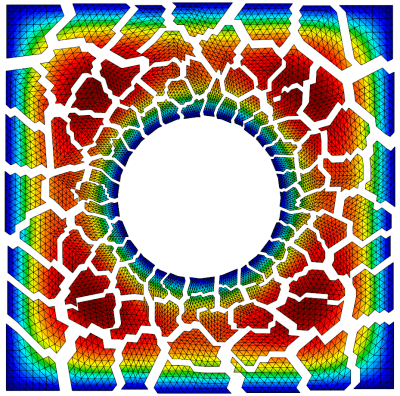
Parallel version of Example 1 on 100 processors with a relatively coarse version of square-disc.mesh. Visualization with GLVis.
Anisotropic refinement in a 3D version of the AMR test. Portion of the spherical domain is cut away in GLVis.
Structural topology optimization with MFEM in LLNL's Center for Design and Optimization.
Test of the anisotropic refinement feature on a random mesh. A slightly modified version of Example 1. Visualization with GLVis.
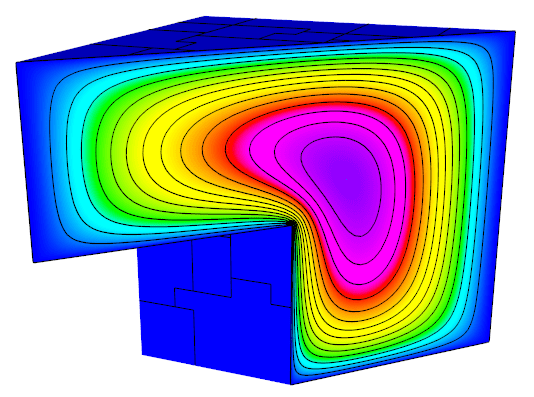
Level lines in a cutting plane of the solution from the parallel version of Example 1 on 64 processors with fichera.mesh. Visualization with GLVis.
Cut image of the solution from Example 1 on a sharply twisted, high order toroidal mesh. The mesh was generated with the toroid miniapp.
Cut image of an induction coil mesh and three sub-meshes created with the Trimmer miniapp. Visualization with VisIt.
Viscoelastic flow of blood through an artery with aneurysm modeled by the Hookean dumbbell model discretized with BCF-method (Navier-Stokes+SUPG). Image courtesy of Andreas Meier, as part of the 2021 MFEM Workshop Visualization Contest.
Visualization of time-averaged mean flow from a compressible, DG Navier-Stokes solver using MFEM modeling a plasma torch. Image courtesy of Karl W. Schulz, as part of the 2021 MFEM Workshop Visualization Contest.
Streamlines of the electric field generated by a current dipole source located in the temporal lobe of an epilepsy patient. Image courtesy of Ben Zwick, winner of the 2022 MFEM Workshop Visualization Contest.
Flow through periodic Gyroid micro-cell, MFEM Navier mini-app with additional Brinkman penalization. Image courtesy of Mathias Schmidt, as part of the 2022 MFEM Workshop Visualization Contest.
🎬 Turbulence effect of the Kelvin-Helmholtz instability in tokamak edge plasma using an MHDeX code developed at LLNL. Image courtesy of Milan Holec, as part of the 2023 MFEM Workshop Visualization Contest.
🎬 Topology optimization with conformal meshes to maximize beam stiffness under a downward force on the right wall. Image courtesy of Ketan Mittal and Mathias Schmidt, as part of the 2023 MFEM Workshop Visualization Contest.
Penrose unilluminable room appears rather illuminable in 3D (at least when constructed as a solid of revolution). Image courtesy of Amit Rotem, as part of the 2023 MFEM Workshop Visualization Contest.
Heat flux magnitude in a convection - (anisotropic) diffusion simulation with MFEM text as the initial temperature profile. A single implicit step of the HDG scheme was used. Image courtesy of Jan Nikl, winner of the 2024 MFEM Workshop Visualization Contest.
